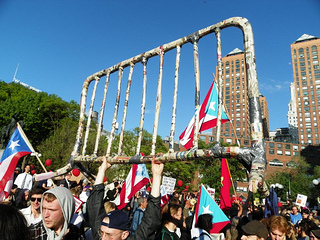Protesters Resort to Violence on May Day
On May Day, the international holiday celebrated in over 80 countries last Tuesday, people across the nation assembled to bring awareness to the rights of the working class. Hundreds of thousands of people (the number varied, depending who you asked) assembled throughout major American cities to force the topic of their blue-collar strife into the national media conversation.
With the declining-but-still-perilous 8.6 percent national unemployment rate, the student loans continuing to be cut by the government, and the Arizona SB 1070 immigration law that will officially go into effect this summer, the protestors couldn’t have had better timing to take part in the international holiday – finding a wellspring of reasons to gather in the name of the injustices that continue to widen the gap between the rich and the poor.
However, any words spoken by the protestors were clouded by the outbreak of violence which disrupted these protests nationwide. At least 13 people were reportedly arrested in Los Angeles after the police began to disperse them when the 10pm city permitted time elapsed. In Seattle, black-clad radicals broke the windows of businesses, slashed the tires of parked cars, and defaced downtown building facades. In Oakland, 39 were arrested, after a local police department building was found vandalized by the local protesters.
Though the violence displayed on May Day was undoubtedly inspired by unattended frustrations, the fact that the anger transcended those regarded as upper class and reached the local small businesses and parked cars, shows that we can’t take these protests as more than misguided sadism. Violence will definitely draw attention, but it will also steer it away from the attention that’s needed to appropriately battle the rights that the protesters claim they want.
As Oakland mayor Jean Quan stated, “May Day in Oakland has traditionally been dedicated to supporting immigrants’ rights with broad community support for large marches to City Hall. Once again, a small group intent on confronting the police and doing damage to public buildings and businesses in our city disrupted yesterday’s largely peaceful events.”
She’s only partially correct, as – ironically – May Day was originally meant to commemorate the Haymarket riots in Chicago on May 4, 1886, when a worker’s strike was taking place before a bombing killed a few civilians and police officers while wounding several others.
Regardless, the incriminating dispositions of these irreverent protesters are doing them more harm than the properties they’ve destroyed. For a movement to gain attention, it can’t keep preaching to the choir, it needs to call out those who straddle along the fence, the tentative non-partisans, who would never be coaxed into becoming sympathizers when they see headlines of reckless vandalism. May Day showed them and the rest of the nation, just how far away the working-class movement is from realizing its goals.
[Photo by The Eyes Of New York]Paul Adams is a writer who lives in Los Angeles, follow him on Twitter @Yustomovic.


